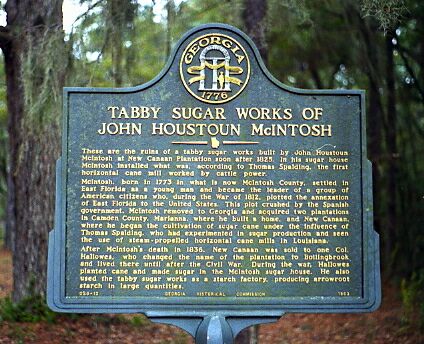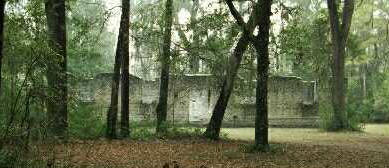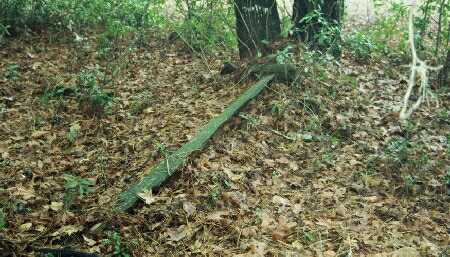 |
| McIntosh Sugar Mill Ruins
Text from the Georgia Historical Commission Plaque: TABBY SUGAR WORKS OF JOHN HOUSTOUN McINTOSH These are the
ruins of a tabby sugar works built by John Houston McIntosh at New Canaan
Plantation soon after 1825. In his sugar house McIntosh installed what was,
according to Thomas Spalding*, the first horizontal cane mill worked by
cattle power. *Thomas Spalding was the great-grandson of John Mohr McIntosh / John McIntosh Mohr. Tabby is a concrete-like substance made of lime, water, powered oyster shells, and crushed (but chunky) oyster shells. As the process of making tabby was very labor intensive is faded out of fashion once slave labor was no longer available. McIntosh Sugar Mill Damage
Clearly, the person or persons who did this are very ignorant. The
building was built around 1835. It is made out of tabby, which is a compound
(primarily) of oyster dust, oyster shells, lime, and water. It is a rather
strong material, but also very porous. What that means is that substances
such as spray paint are very difficult, if not impossible, to remove. Most
chemical solvents either will not work or do more damage then good. I have been in contact with various people who know much more about tabby then I do. I have been asking for any information on the best way to remove this damage. If removal is not possible, then I would like to find out what can be done to safely cover it up. If the damage can be covered, for now, then possibly in the future a way can be found to remove the paint. Until then, at least the damage will not be an eyesore or an encouragement to other idiots to expand the damage. So far, the consensus has been that it probably will not be possible to remove it, but a safe cover-up may be possible. I am waiting for the instructions to be sent to me so that I may pass on the information to those in charge of the site. I am also waiting on some information on how to make a poultice to gradually draw the paint out of the stone. All this, of course, would have to be done with the knowledge and consent of the owners of the property. Someone also took down part of the wooden fence that fronts the property and drove to the rear of the building. Tire marks were clearly visible in the grass. They also left trash in the area. Even though I have known of this damage for some time, I have been reluctant to publicize the problem because I feared some well-meaning individual would attempt to remove the paint with a damaging solvent.
I resent the people who have done this damage. These parks do not belong
to the vandals alone to happily destroy because they are bored, spoiled, or
have had a bad day. I, for one, do not ca For the record, Rick and Jo, my friends and I didn't think your "art work" was cool. In fact, when we saw it the first thing out of our mouths was, "What idiots!" If that's what you want to be remembered for, more power to you. But do the rest of us a favor, don't ram your crap down our throats - you don't have the right. |





 In
December, my friend and I visited the McIntosh Sugar Mill located on Spur
40. To my shock, I found the back of the building had been spray-painted. I
had visited the site a couple of months before that and at that time, the
damage was not present.
In
December, my friend and I visited the McIntosh Sugar Mill located on Spur
40. To my shock, I found the back of the building had been spray-painted. I
had visited the site a couple of months before that and at that time, the
damage was not present.
 Until
we catch the people who are doing all this damage to our parks, the citizens
of this area must been on the look out for suspicious behavior around our
recreational / historical sites. Do not assume someone else will report
them! Parents, in the case that the offenders are underage, please enforce a
curfew on your children. If your children damage public property because you
allow them to roam the area after hours, you are equally responsible for the
damage they cause.
Until
we catch the people who are doing all this damage to our parks, the citizens
of this area must been on the look out for suspicious behavior around our
recreational / historical sites. Do not assume someone else will report
them! Parents, in the case that the offenders are underage, please enforce a
curfew on your children. If your children damage public property because you
allow them to roam the area after hours, you are equally responsible for the
damage they cause. re
about the reasons they have done this damage. These parks and historical
sites are just as much mine to enjoy. In the case of teens doing the damage,
I feel I have more right to these areas because at the least I can
appreciate them. In addition, I pay taxes to help maintain them.
re
about the reasons they have done this damage. These parks and historical
sites are just as much mine to enjoy. In the case of teens doing the damage,
I feel I have more right to these areas because at the least I can
appreciate them. In addition, I pay taxes to help maintain them.